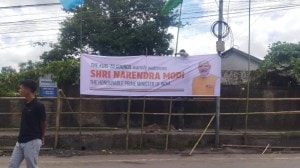How many gods, Yajnavalkya?
On Republic Day evening, at a friend’s house, a bright, articulate Pakistani girl waxed wroth about the â€&t...

On Republic Day evening, at a friend’s house, a bright, articulate Pakistani girl waxed wroth about the ‘‘uneducated response’’ of many Indians to Islamic marriage laws: ‘‘They keep asking me, what will you do if your husband takes another wife? In fact, Islamic law is very strict about this. It’s not as easy as everyone thinks.’’ Indeed, popular films like Nikah have tried to correct this perception, but lots of people simply assume otherwise. It sets me wondering, yet again, about mutual misunderstandings, and how culture is usually confused with faith.
Besides the caste system and dowry deaths, the biggest issue that a modern Hindu is taunted about (and cannot handle) is the so-called pantheon or galaxy of gods. It seems so un-chic and uncool, so irrational and embarrassing to one’s self-image, plead most.
But hold it, in fact, there is only One. It was the poetic fancy of our imaginative ancestors that created many aspects to Divinity. Plus, we are permitted to pray to God as an ishta devata, or personal deity. The idol, again, is only a representative object. It is a thing of beauty, created with reverence, before which to park the real focus point of worship: the flame. The flame represents Truth, burning away all ego, deceit and illusion, it stands for the pure energy or life force (heat) that keeps us and our world alive.
Don’t believe me? Think it’s a post-colonial trick of words? Right, let’s turn to the Brhadaranyaka Upanishad, which leaps with such terrifying drama that it reads like a script for the AXN channel. Let’s check out scary old Yajnavalkya, capo of rishis and lawgivers, whose mind seems to go like a piledriver.
In the section called the Ninth Brahmana, a hapless soul called Vidaghda Shakalya asks, ‘‘How many gods are there,Yajnavalkya?’’
‘‘As mentioned in the hymn of praise to the Vishve-devas, 303, and 3,003.’’ ‘‘Yes, but how many gods are there, Yajnavalkya?’’
‘‘Thirty three.’’
‘‘Yes, but how many gods are there, Yajnavalkya?’’
‘‘Six.’’
‘‘Yes, but how many gods are there, Yajnavalkya?’’
‘‘Three.’’
And so on, down to One.
The core group of 33, explained the rishi, were manifestations or aspects of the life force, that had been given names and identities out of respect for their importance in supporting our existence. For instance, the eight Vasus are the fire, the earth, the air, the sky, the sun, the heaven (space or antariksh), the moon, the stars. The 11 Rudras are the 10 breaths in a person, with the mind as the 11th. When they depart from a mortal body, the relatives weep. Because they make us weep, they are called Rudras.
The 12 Adityas are the 12 months of the year, carrying all this. Indra is the thunder and Prajapati is the sacrifice (animals).
Thus we have 33 aspects to the Creator.
Reduced to six, the aspects are the five elements and the antariksh.
Reduced to three, they are the three worlds. Reduced to two, they are food and breath. And reduced to the One, it is Breath, the prana or life, because of which all else came to be and continues to be.
"Katama eko deva iti? Prana iti sa brahma, tyad ity aachaksate." Which is that one God? The Breath. He is Brahman. They call him tyat (that).
In other words, the Creator is the One who gives and sustains life in all its forms and functions, the One God who has different names and attributes because of the many jobs that must be done to keep Creation ticking!
Photos





- 01
- 02
- 03
- 04
- 05


























